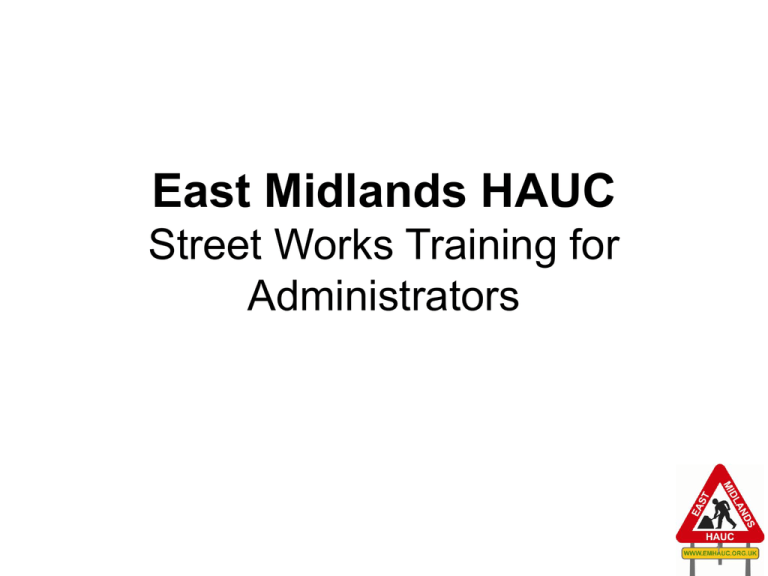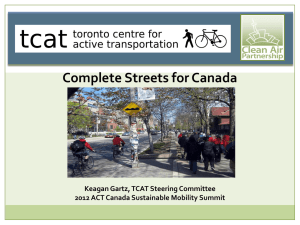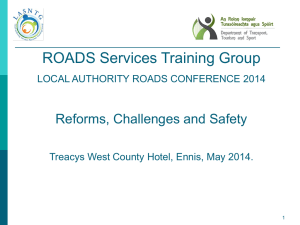HERE - East Midlands HAUC
advertisement

East Midlands HAUC Street Works Training for Administrators 1 Street Works Training for Administrators Course Content • Street Works Legislation • Co-ordination • National Street Gazetteer • Streets Subject to Special Controls • Section 58 • Notice Classification • Works Categories • Notice Requirements 2 Purpose of the Traffic Management Act 2004 Government Vision A central part of the Government’s strategy to tackle congestion • Appointment of Traffic Managers (within Local Authorities) • Network Management Duty places requirement on Highway Authorities to manage their networks effectively • Providing for better co-ordination and control of street works • Making Authorities’ powers over moving traffic and parking enforcement more effective 3 Street Works Legislation • New Roads and Street Works Act (NRSWA) still continues • Traffic Management Act (TMA) amends, replaces and adds to existing requirements under NRSWA • The focus is on administration and co-ordination of works – no change to how works are physically carried out on site • This legislation covers the whole life cycle of works – from planning to completion 4 Areas of Impact • Increased importance of co-ordination • Increased powers for Highway Authority (directions & restrictions) • Changes to noticing regime • Changes to Section 74 • Introduction of Fixed Penalty Notice scheme • Introduction of Permit scheme 5 Co-ordinating Works NRSWA Section 59 Requires Street Authorities to use their best endeavours to co-ordinate the execution of works • In the interests of safety • To minimise inconvenience to persons using the street • To protect the structure of the street and the integrity of apparatus in it 6 Co-ordinating Works NRSWA Section 60 Requires utilities to use their best endeavours to co-operate with the street authority, and one another, in the co-ordination of the execution of works. Co-ordination enables differences between works promoters competing for space or time in the street, to be resolved in a positive and constructive way. Street works reduce the width of the street available to traffic, pedestrians and other users. The level of disruption caused by restricting movements will depend on the type of works and how busy the street is. 7 Co-ordination Process Information Analysis Consideration Co-operation • The Street Authority needs accurate and timely information on what is proposed and when it is happening. • The Street Authority needs to analyse the information. • The Street Authority must consider whether any changes are required to minimise disruption before agreeing the proposals. • All parties must co-operate with the Street Authority to achieve the minimum disruption. 8 Co-ordination Process Effective co-ordination is essential to minimise traffic disruption whilst allowing promoters the necessary time and space to complete the works. Works Promoters should recognise that the statutory notice periods are the minimum and wherever possible, longer advance notice should be given. If changes are needed, the earlier the Street Authority informs the Works Promoter, the easier it will be for the Works Promoter to comply. 9 National Street Gazetteer (NSG) • Every Street Authority produces a gazetteer listing the streets in their area • It is held centrally by the NSG custodian – Intelligent Addressing – on their website • All Works Promoters have access to this website and can obtain their copy • Each individual street has it’s own reference number – a USRN (Unique Street Reference Number) • Additional information known as ASD (Additional Street Data) is attached to the street. ASD can include; – Reinstatement Category – Traffic Sensitivity – Special Engineering Difficulty 10 National Street Gazetteer (NSG) • The Street Authority is responsible for streets which are publicly maintainable and prospectively maintainable. • Works on private streets have to be notified to the street works register (via the Street Authority), although they are not responsible for that street • Publicly maintainable streets will generally be on the NSG • Prospectively maintainable streets will usually be for development sites and may not be on the NSG. • Contact the relevant Street Authority for guidance on NSG information, identification of correct USRN and for permission and guidance to raise a Provisional Street. • See www.emhauc.org.uk for contact details of Street Authority representative 11 Streets Subject to Special Controls Categories of Street • Protected Streets • Streets with Special Engineering Difficulties • Traffic Sensitive Streets Reasons why special controls are imposed When planning works you need to consider not only the nature and duration of the works but also the effect on residents and local communities and the importance of minimising delay and inconvenience to road users and the need to protect structures and apparatus in the street. 12 Streets Subject to Special Controls Traffic Sensitive Streets Works Promoters should not work in the carriageway of traffic sensitive streets at sensitive times unless there is no alternative. Depending on circumstances Traffic Sensitivity can apply to: • Carriageway, footway or pedestrian area only • A part or all of the street • Certain times of the day • Certain days of the week • Certain days of the year 13 Streets Subject to Special Controls Streets with Special Engineering Difficulties (SED) Example of a bridge If SED applies, you must ensure the SA, or relevant authority is contacted at planning stage, before notices are submitted. 14 Streets Subject to Special Controls Streets with Special Engineering Difficulties (SED) Example of a retaining wall If SED applies, you must ensure the SA, or relevant authority is contacted at planning stage, before notices are submitted. 15 Streets Subject to Special Controls Streets with Special Engineering Difficulties (SED) Example of an embankment If SED applies, you must ensure the SA, or relevant authority is contacted at planning stage, before notices are submitted. 16 Streets Subject to Special Controls Streets with Special Engineering Difficulties (SED) Example of a culvert If SED applies, you must ensure the SA, or relevant authority is contacted at planning stage, before notices are submitted. 17 Section 58 Restrictions Why Impose Restrictions? Residents and road users see roads being dug up within months of resurfacing or see roads being dug up repeatedly by different Works Promoters and conclude that there is no apparent co-ordination of works. To prevent this happening, a Street Authority can limit further works in a Street (or in a length of street) after substantial road or street works by imposing a Section 58 18 Section 58 Restrictions What are Substantial Road Works? Substantial Road Works extend at least 30 metres continuously and: • Reduce the width of a footpath, footway, bridleway or cycle track by more than two-thirds, or • Prohibit the use of the carriageway by vehicles, or • Reduce the width of the carriageway by more than one-third 19 Section 58 Restrictions Creating a Restriction Publish on Website SA gives notice 3 months before work planned Put on Street Works Register Copy to other Parties Utilities have 20 days to respond with works planned in restriction When the substantial roadworks are completed, the Street Authority gives a notice to the parties concerned stating that the works have been finished and the restriction is in force. 20 Section 58 Restrictions STREET (INCLUDING FOOTWAY, CYCLEWAY ETC) WORKS TYPE CAT 0,1,2 & TS CAT 3&4 NON TS 1: RECONSTRUCTED (Removal & replacement of some or all of the various layers that make up a road pavement) 5 Years 5 Years 2: RESURFACED (Removal of the running surface & its replacement to restore surface integrity & skid resistance) 3 Years 3 Years 3: OTHER SUBSTANTIAL ROAD OR STREET WORKS 1 Years 6 Mnths COMBINATION OF 1 OR 2 PLUS 3 Higher of Figures CUSTOMER CONNECTIONS IMMEDIATE WORKS (EMERGENCY & URGENT) 20 Days in all cases Exempt 21 Directions Directions – Section 56, Section 56A & Section 66 • SA can direct on date and timing of works (56) – before or during works – (If directed to work at night it is the Street Authority’s responsibility to reach agreement with Environmental Health Officers) • Section 56A is the Power to give directions as to placing of apparatus • SA can direct us not to place new apparatus in a street • Section 66 “Avoidance of unnecessary delay or obstruction” 24 hour response • Right of appeal 22 Notice Classifications Why Notice? The notice system performs at least seven functions; 1. It is a vital component of the co-ordination process 2. It enables emergency notices, which can prompt the emergency procedures of other organisations 3. It triggers the inspection regime 4. It forms the basis of records for reinstatement guarantee purposes 5. It records who has worked at a particular location 6. It facilitates charging regimes 7. It is an essential element of the Street Authority’s responsibility for keeping a register. The term “notification” includes notices, notifications, registrations or reinstatement, directions, responses, and cancellations 23 Which works require a notice? If the works involve one or more of the following… • Involve the breaking up or resurfacing of any street • Involve opening the carriageway or cycleway of TS streets at TS times • Require any form of temporary traffic control as defined in the Red Book • Reduce the lanes available on a carriageway of 3 or more lanes • Require a temporary traffic regulation order or notice, or the suspension of pedestrian facilities • Require a reduction in the width of the existing carriageway of a TS street at a TS time 24 Works Categories & Durations WORKS CATEGORY IMMEDIATE – EMERGENCY IMMEDIATE URGENT PLANNED DURATION WORKS DESCRIPTION By Agreement Works required to end, or prevent, circumstances, either existing or imminent, that might cause damage to people or property. The term includes works that do not fall within that definition but which cannot be severed from those that do. Remedial works to dangerous, defective reinstatements come in this category. By Agreement Non-emergency works required to prevent, or put an end to, an unplanned interruption of any supply or service. To avoid substantial loss to the undertaker in relation to an existing service. To reconnect supplies or services where the undertaker would be under a civil or criminal liability if delayed until after the planned notice period. This includes works that cannot be reasonably severed from such works. 25 Works Categories & Durations WORKS CATEGORY MAJOR PLANNED DURATION WORKS DESCRIPTION In annual operating programme 11 Days or More Known about 6 months in advance Involve a Temporary Traffic Regulation Order STANDARD Between 4 and 10 Days Inclusive Planned Works – defined by duration. No Temporary Traffic Regulation Order required. MINOR 3 Days or Less Planned Works – defined by duration. No Temporary Traffic Regulation Order required. How do we decide what Notice to send? The type of notice you send depends on the Category of Works. 26 Works Category Selection Is work required to prevent or end a dangerous situation (including dangerous defects/reinstatement)? YES Immediate Emergency Works YES Immediate Urgent Works YES Major Works YES Minor Works NO Is work to prevent/end an unplanned interruption to supply or to avoid substantial loss or reconnect a supply? NO Are the works in the annual programme or need a TTRO* or have a planned duration of 11 days or more? NO Do the works have a planned duration of 3 days of less? NO Standard Works *Temporary Traffic Regulation Order 27 General Notice Rules • Must be electronic noticing system which conforms to the Technical Specification for EToN (Electronic Transfer of Notices) • Description must be clear and in plain English with no industry jargon • Durations are calculated in working days or calendar months • All notices should identify start and end dates so that the duration can be calculated • The notice period starts when the recipient receives the notice, not when it is sent • A notice shall contain only one street • A notice shall contain proposed Traffic Management details NOTE: Notices appear on Street Authority’s websites for public information 28 Notice Requirements Advance Notice / Initial Notice (Section 54) • All Major Works require an Advance Notice (3 months in advance) • Notice must include all available information about the works • Must have an estimated end date • Must cross reference to any project of which the works are part Notice of Starting Date / Confirmation Notice / Initial Notice (Section 55) • • • • All registerable works require a notice of starting date Notice must include all available information about the works Must have an estimated end date Must be cross referenced to any project of which the works are part • Must indicate intention to work outside normal working day 29 Notice Requirements Immediate Works Notice / Initial Notice (Section 55 or 57) • Notice must be given as soon as reasonably possible, and must be given within 2 hours of start of works • If the SA does not have arrangements for receiving/responding to ‘out of hours’ notice, this must be served by 10am the following working day Actual Start (Section 74 (5B) & (5C)) • Works do not have to start on the date proposed in the Section 55 notice but must start within the validity period • Notice of actual start date must be given to begin the prescribed or reasonable period • Works may not begin before the date stated in the Initial notice unless an Early Start date has been agreed • This notice must be given by the end of the next working day after works began • The identity of the main contractor must be provided on this notice • NOTE: In the case of Immediate Works the Section 55/57 notice is also the Actual Start Notice 30 Notice Requirements Section 74 Duration Challenge Notice (Section 74 (4)) • SA may dispute a Duration Estimate • SA must give the WP it’s own estimate using a Duration Challenge Notice • SA must send this notice with 5 working days for Major or Standard works • SA must send this notice within 2 working days for Minor or Immediate works • If the WP does not accept the SA’s Duration Challenge it must notify the SA within 2 working days using a Duration Challenge Non Acceptance Notice. Notice of Revised Duration Estimate • A WP may give a Notice of Revised Duration Estimate ay any time before the estimated end date. Reasons must be given to justify extending the works. • SA may dispute a Revised Duration Estimate, but this must be within 2 working days 31 Notice Requirements Section 74 Works Stop (Section 74 (5C)) • A Works Clear notice is used following interim reinstatement • A Works Closed notice is used following permanent reinstatement • The relevant notice must be given by the end of the working day, following the day which the works were clear/closed • All spoil, excess materials, stores, signing, lighting and guarding must have been removed from site before the works can be regarded as complete. Works Status Correction – Revert Start or Revert Stop • To be used only when Works Start or Works Stop notice sent in error • There must be agreement with the SA to issue notice 32 Other Possible Notices Registration of Reinstatement (Section 70) • WP must notify the SA within 10 working days of completing reinstatement using a Registration of Reinstatement (S70) notice. It must specify if the reinstatement is interim or permanent . • The notice must include the following information; • whether the reinstatement is interim or permanent • Grid references (centre point <10m,start & end <10m) to 1m accuracy • Dimensions of each reinstatement (length, width & depth) • Date the site was reinstated (start date for the guarantee period) • Reinstatement construction method • Number of inspection units Cancellation of Proposed Works/Phase • To be used where a planned works/phase has not started, and is not going to take place, or if the original notice is fundamentally incorrect • Must be issued before Actual Start notice 33 Other Possible Notices Works Data Alteration – Error Correction or Works Data Variation • This notice is used to correct errors and amend values in previously notified data from previous notifications. Prior agreement from the street authority is required for certain corrections. For example a works description, a location description and co-ordinates can be altered. Bar Holes • Bar holes must be reinstated • Must be registered within 10 working days of completing reinstatement • Registration must include grid references/co-ordinates to 1metre accuracy 34 Notice Requirements Early starts The early start reference process may be implemented by some Street Authorities. You will have to phone the Street Authority to obtain an agreement reference to gain permission for the early start before issuing the notice. This number should then be included in the appropriate field for Agreements within the EToN system. 35 Notice Requirements 36 Notice Requirements 37 What if it goes wrong? • Legal requirement to notice our works accurately • Fixed Penalty Notices £80/£120 per failure • Section 74 charges Cat 0,1 Cat 2 Cat 3,4 (TS) Cat 3,4 (not TS) Major & Standard £2,500 £2,000 £750 £250 Minor & Immediate £500 £500 £250 £100 38 Summary • Street Works Legislation • Co-ordination • National Street Gazetteer • Streets Subject to Special Controls • Section 58 • Notice Classification • Works Categories • Notice Requirements 39






